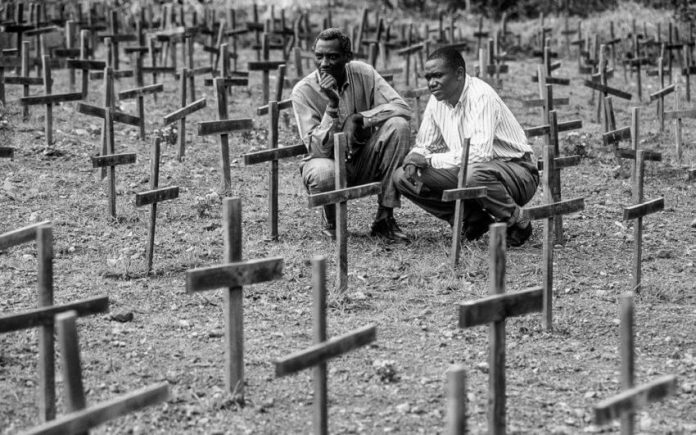This article is written by Ayush Arora, from Dr. Ram Manohar Lohia National Law University, Lucknow. In this, we shall deliberate about genocide, i.e. the phenomenon of mass killing.
Table of Contents
Introduction
We come across several instances of massacres, being caused by some or the other terrorist organizations. An atrocious tradition existing for years, it is very recently that we have begun to apprehend the consequences of such mass killings, and have taken steps to cure the cancer, and eradicate the tormenting tradition. Lately, several legislations have been formulated worldwide and at country levels to do away with the causes of the same and to tackle the Instruments which assist in the execution of the same. To cite instances, restrictions on acquiring and possession of arms (especially semi-automatic), attempts to curtail malpractices, like untouchability, efforts to induce worldly brotherhood and keep all religions at par with one another, not trying to diminish, or taint the prestige of one with respect to another.
Causes and instances of genocide
There have been several causes of genocide. The root, along with several instances of the same are dealt as under:
-
Racial discrimination
Several instances of genocide have been witnessed, the underlying factor of which, was racial discrimination. The practice of presuming one’s race to be superior to the other, is its essence. The application of such brutal discriminations were visible in the practices of apartheid, when, in South Africa, where the imperial white men disregarded the black men. The classification of population was 3-faced, depending upon the skin color of the subjects. The African blacks were named Bantu. They were not entitled to meddle in the areas occupied by the white, and needed a pass to access those, if need be. They used to live in an area especially designated for their residence, named Bantustan.
The second in line of classification, after bantu, were colored (the people of mixed race, such as Indians) and finally the whites, who, obviously were imperial British colonialists. This is a classical example of racial discrimination. The agitated subjects, subsequently revolt violently leading to mass killings of the discriminators. Let us now analyse certain examples where such discrimination led to massive genocides:
The holocaust
We all are aware of the plight of jews in the reign of Hitler. “Concentration and mass extermination” camps were established, slaughtering masses of jews at one go. Several thousands were exposed to toxic gases, poisoning the jewish population to their graves. Along with jews, the German government was also keen at killing other sects of entities, including slaves, Romanians and even mentally handicapped, for there was no incentive to grow the German mainland. The sorrowful event led to a mournful demise of over 16 million people, embarking one of the most chronic genocidal histories on the globe.
-
Religious prejudices
Next in line, after race, is religion. There have been massive genocides, wherein members of one religion, in an attempt to deter subjects of another religion to convert into their own, intimidate them by killing or harassing them. Let us analyse certain examples of this class too:
The dominance of Muslims
The reference is currently being made towards the catastrophes that muslim ardents hurled upon subjects of other religions. We know the sikh-muslim history, wherein sikhs were forced by muslims to convert into Islam. They used brutal methods to torture them, and force them to convert into Islam. In the stifle, they ended up killing several Sikhs, Hindus, and a plethora of other people. Lets here discuss this one event in detail. Once, in an attempt to deter Sikhs into embracing Islam, Mir Mannu (Governor of Lahore in 1748), sent his army door-to-door to grapple Sikh women, capture them, and drag them to Lahore. The armies, upon such orders, collected hundreds of Sikh women and commenced their journey to the land of Lahore. Most of the aged women, who could not walk, were murdered in half-way. The ones who managed to reach, were imprisoned. They were forced to grind 40 pounds of wheat with a grinder much heavier than the usual. They were provided solely with a bowl of water and quarter of a bread to eat. To make them adopt Islam, the ruler ordered to severe the women off their infant babies, kill them before their eyes, and to spare only the ones who espoused Islamism. 300 infants were killed before the helpless eyes of their mothers, embarking one of the hysterical events of genocide to impose ones religion over others. Though despite these atrocities, not even a single of those women embraces Islam, but what happened later is nugatory to the concerned topic. Though the act and its salient features would be exhaustively discussed in later part of the article, but, according to convention on prevention and punishment of the crime of genocide,1948 (Article 2), any act of:
i) Killing members of a group;
ii) Causing serious mental or bodily harm to members of a group;
iii) Deliberately inflicting upon a group, conditions of life, calculated to bring about it’s physical destruction in whole, or in part; and
iv) Imposing measures intended to prevent the growth of the group (Such as killing of children of the ethnic group).
These are some acts which amount to genocide. In the presently discussed scenario, all the four were effectively met, making it a perfect epitome of genocide being howled upon a community, for religious disparities.
-
An attempt to occupy land
Military to capture territories, since the very past, has led to enormous losses of lives. Acts of armies, to occupy land for their benefits, amount to acts of genocide. Let us envision certain illustrations where such military warfare led to severe breach of human rights, and the evident offence of genocide:
The atrocities on Sikhs by Muslims
Several illustrations regarding muslim-sikh genocidal events are being demonised, because we all are aware of that milestone of Indian history. In an attempt to capture territories occupied by Sikh regime, Mughals dispatched an army. Banda Singh, the army general under Guru Gobind Singh, along with his sikh soldiers, were ambushed in a Garhi. In December 1715, Abdu Samad, was ordered Banda’s capture by Farukh Siyar, the then Sultan of Delhi. He intended to gift Banda Singh to Farrukh, but considered solely Banda’s capture to be a very menial present. He then ordered his army to behead every Sikh they found on their way from Lahore to Delhi, and carry their heads alongwith. The procession, while returning, had Banda Singh with his army, and 200 skulls attested to the spearheads of those men. Such a showcase of brutality continues to be an unparalleled projection yet. Following their arrival at Delhi, all of the Sikhs (around 700) were tortured and beheaded at Khooni Darwaza. Following that, Banda Singh was taken to Qutb Minar, where he was tortured and 26 of his closest soldiers were beheaded before his eyes, so as to intimidate him into revealing Guru Gobind Singh’s army strategies; but he did not budge. Subsequently, to further traumatise him, his son was seated in his lap, and his chest was ripped open, his heart was extracted, and thrusted in the mouth of Banda Singh. This is the utmost extent to which the killing of masses, to acknowledge the army strategies of your opponent, and to attempt to occupy land can be lucidly demonstrated.
Aceh war crimes
Aceh is a province located in north-western tip of Island of Sumatra, and constitutes around 3% of the country of Indonesia. While the territory is Inhabited by muslim population, the region gained some autonomy in 1959 due to ethnic and cultural differences of the inhabitants. The area, though, is very rich in timber, which could be used for infrastructural development of the whole country, as well as manufacture of arms for the military. The native Muslim inhabitants, however, won’t permit woodcutting activities, and claim the land and resources to be belonging to their homeland, not as a public property. The Indonesian government then deployed armed and paramilitary forces to get hold of the region. Also, to comfort their feat, the Jakarta government, in 2003, imposed a state of emergency in the region, and barred almost all outsiders from entering the province, including humanitarian groups and international human right observers. Over next 18 months, over 2000 inhabitants were killed by Indonesian military, marking yet another milestone of genocide for enjoying territorial priviliges.
-
Fanaticism
As much weird as it might sound, certain inappropriate and foolish decisions have also led to genocidal activities. To support the assertion, let us look at an example of Cambodian genocide. In its 5 years of rule, a maoist movement, named Khmer Rouge orchestrated a ruthless campaign, that was to recreate society from ground-up. Three-million people were expelled from cities because of which they resettled in rural areas, while all those labelled as capitalists or intellectuals (even the ones who used eyeglasses) were assassinated. Markets were destroyed, schools were closed, private property was banned and the use of money was outlawed. Within 1975-1979, it was one of the most sweeping and radical social experiments ever to be tried in history. Witnessing the death of as many as 1.7 million people, it proved to be a gigantic failure.
So these, in essence, were some of the prominent causal factors of genocidal activities which took place in different arenas of the world.
Steps to curb genocidal activities
It is not the case that international organizations have ignored the issue of genocides and left it to be determined by the fate of the actors. Several prominent legislations, both at national and international levels, have been formulated as an effort to do away with this barbarity. Lets us now analyse one of such infamous legislations and it’s features:
Convention on the Prevention and Punishment of the Crime of Genocide, 1948
The Convention was adopted by the General Assembly of the United Nations on 9th December, 1948, and came into force on 12th January, 1951, as per Article XIII of the Convention. As of now, the Convention has been ratified by as many as 152 countries, and India became its signatory on 29th November, 1949. The salient features of the Act are as follows:
i) Article I submits that parties must consider genocide, whether in times of war or in times of peace, to be a heinous crime.
ii) Definition of genocide: Article II of the Convention illustrates the definition of genocide to be as follows:
- Killing members of the group;
- Causing serious bodily or mental harm to members of the group;
- Deliberately inflicting on the group conditions of life calculated to bring about its physical destruction in whole or in part;
- Imposing measures intended to prevent births within the group;
- Forcibly transferring children of the group to another group.
For the current purpose, as stipulated as per the provisions of aforesaid article, a “group” shall mean to include, in whole or in part, a national, ethnical, racial, or religious group.
iii) Punishable offences: It is not solely genocide which draws culpability from the Convention, but other associated offences, such as conspiracy to commit genocide, attempt to commit genocide, complicity in genocide and direct/public incitement to commit genocide, all fall within the ambit of offences liable for punishment, as enumerated in Article III.
iv) Nature of offenders: The borderline of offenders is not narrowed down solely to individuals/groups planning/executing genocide. Even the constitutional rulers, decision of an anarch, public service officials, etc., are liable for the offence, if found guilty for any genocidal correlated acts as mentioned in point Article II.
v) Punishment for genocide: Respecting the sovereignity of nations, the convention asserts to enact legislations for genocide as per the constitutional provisions of subject countries. The accused shall be tried in a competent court, and if found guilty, shall be retributed in accordance to the provisions of the legislation. The convention itself does not entail any particular punishment for the aforesaid offence.
vi) Extra-territorial assistance: In accordance with Article VIII, the nations, if need be, can seek assistance from United Nations to aid in eradication/suppression of Genocide suspected in their territory.
vii) Intra-convention disputes: In lieu of Article IX, all disputes arising out of interpretation conflicts amongst nations, in relation to the convention, shall be dealt by the International Court of Justice.
vii) Denouncement of the convention: The convention, in accordance with Article XIV, was to remain effective for a period of 10 years post its formulation, followed by successive periods of 5 years for the parties who have not denounced its perusal. A nation may denounce the convention by dispatching a notification to the Secretary General of the United Nations, mentioning such denouncement, at least 6 months prior to the lapse/renewal of the Convention. Also, if as a result of denunciations, the number of parties happen to fall less than 16, the Convention shall cease to be in force.
Conclusion
In this article, we have exhaustively read the meaning, causes and reliefs towards genocide. For the sake of readers, the illustrations given were not very remote, and the contents were concise with respect to the headings. Having read it, one must be thrilled to the bones, by acknowledging the apprehension, and the peril that such unwelcoming genocidal activities possess on humanity. Encapsulating the ability of hurling down a reign of terror, killing masses, and eradicating innumerable people, more stringent steps to deal with the epidemic of genocide shall be undertaken, and adhered to, to the best of capabilities. We shall just solicit, and pray that such cancerous genocide shall be exterminated from the realm of the world, to not inflict upon anyone, death, merely because of his race, religion, nationality and definitely not because of some fanatic decision of the autocracy.
References
- Encyclopedia of War Crimes & Genocide by Leslie Alan & Christopher Catherwood
LawSikho has created a telegram group for exchanging legal knowledge, referrals and various opportunities. You can click on this link and join:












